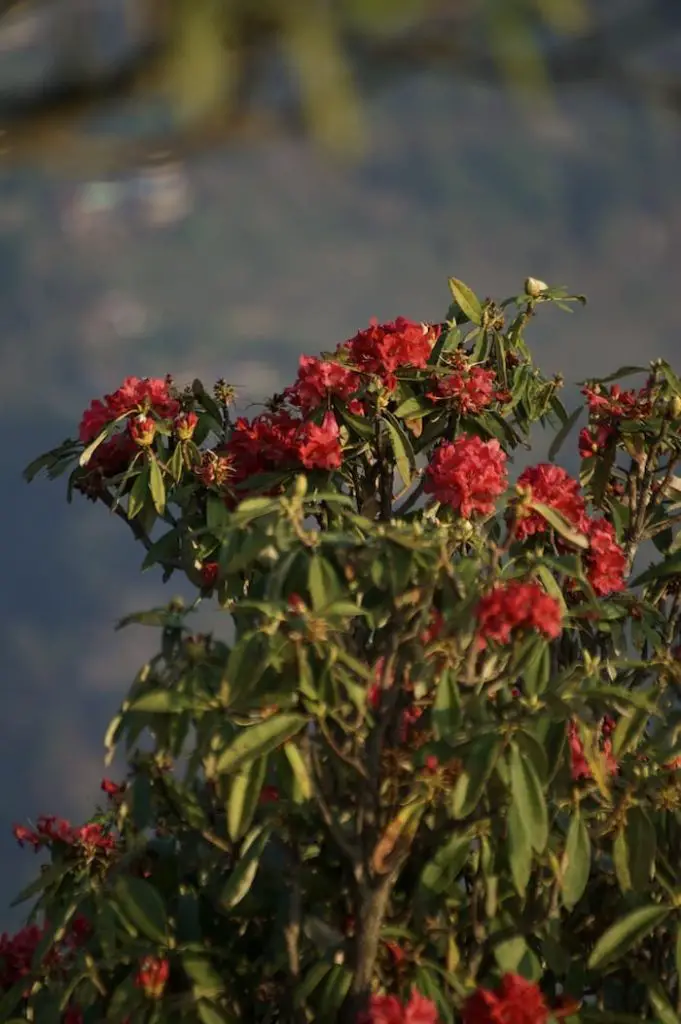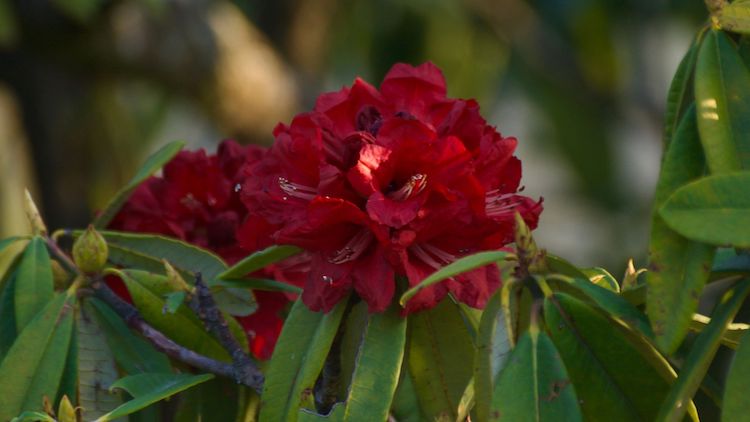Nepal is a land of immense beauty and diversity, with its stunning landscapes, towering Himalayan mountains, and rich cultural heritage. Among the many natural wonders that Nepal is home to, one of the most iconic is the Rhododendron arboreum. This beautiful flower is Nepal’s National Flower and not only a symbol of natural heritage but also cultural and religious significance.
What is Nepal’s National Flower?
The Rhododendron arboreum, commonly known as the Laligurans in Nepali, is Nepal’s national flower. The flower is vibrant and found throughout the country, especially in the high-altitude regions.
It is a large evergreen shrub or small tree that can grow up to 20 meters tall. The leaves of the Rhododendron arboreum are glossy, dark green, and leathery. While the flowers are bell-shaped and range in colors from deep red to pink, purple, and white. The flowers bloom in spring, usually in March and April, covering the hillsides and forests of Nepal in a riot of color.
The Rich History of Nepal’s National Flower

Since 1962, the Rhododendron Arboreum is the designated national flower of Nepal. It is not surprising that Nepal has chosen this beautiful flower as its national emblem. It is an endemic plant found throughout the country, from the foothills to the high-altitude alpine regions, and is deeply rooted in Nepali culture and tradition.
The Lali Gurans also played an important role in the country’s political history. During the Nepali unification campaign in the 18th century, the people used the flower as a symbol of resistance against the invading forces of the British East India Company. The Gurkha soldiers, known for their bravery and tenacity, wore the Lali Gurans on their hats as a sign of their allegiance to the Nepali cause.
Cultural Significance of Nepal’s National Flower
The Laligurans plays a significant role in Nepal’s natural, religious, and cultural heritage. When it comes to religion in Nepal, people consider the Laligurans as sacred and associate it with the Hindu goddess, Durga. The Hindu religion reveres Durga as a deity who embodies feminine power and grace. She is often depicted as a fierce warrior riding a lion or tiger and holding weapons in her many arms.
According to legend, Durga was once faced with a terrible demon she battled for nine days and nine nights. On the tenth day, she emerged victorious. It is said that the Laligurans bloomed from the blood of the defeated demon. The Hindu festival of Dashain, celebrated across Nepal and other parts of South Asia, often retells this story.
The Rhododendron is also associated with Lord Shiva, one of the principal deities of Hinduism. According to Hindu mythology, Lord Shiva meditated in the shade of the Rhododendron tree, and the tree is considered sacred. The red flowers of the Rhododendron arboreum are also believed to be the favorite flower of Lord Shiva. In the Hindu festival of Maha Shivaratri, devotees offer Rhododendron to Lord Shiva as a symbol of their devotion.
Exploring the Ecological and Medicinal Benefits of the Laligurans
Apart from its religious significance, people in Nepal have been using the Rhododendron arboreum in traditional medicine for centuries. The plant’s flowers and leaves have various medicinal properties. It is effective in treating a range of ailments, including coughs, colds, digestive disorders, and skin diseases. Additionally, the Rhododendron is used in traditional Ayurvedic medicine, a system of medicine that originated in India and is still widely practiced in Nepal.
Despite its cultural and ecological importance, however, the Lali Gurans face several threats, including deforestation, climate change, and habitat destruction. In recent years, the government of Nepal and various non-profit organizations have been working to protect the country’s natural resources and promote sustainable development. These efforts include establishing national parks and conservation areas, as well as programs to promote eco-tourism and sustainable agriculture.

List of Flowers Found in Nepal
Apart from the Rhododendron, Nepal is also home to a wide variety of beautiful flowers unique to different parts of the region. Some of the other popular flowers in Nepal include:
- The Himalayan Blue Poppy is a stunning flower native to the Himalayan region that flower enthusiasts highly prize and find difficult to grow.
- The Cobra Lily is a fascinating and unusual plant native to the Himalayan region that gets its name from its striking resemblance to a cobra snake, with its hooded flowers and long, curled tendrils.
- In Nepal, Primrose is a delicate and colorful flower that people prize for its bright colors and sweet fragrance.
- Edelweiss is a high-altitude flower native to the Alpine regions of Europe and Asia that is often used in floral arrangements.
- Himalayan Rhubarb, a flowering plant native to Nepal, is a herbaceous plant with laxative and anti-inflammatory properties that people use in traditional medicine.
- Magnolia is a large and showy flower found throughout Nepal that people prize for its large size, sweet fragrance, and ornamental value.
- Wild Iris is a beautiful flower found in the Himalayan region of Nepal that has a vibrant color and unique shape often used in floral arrangements.
- Daphne, a shrub known for its fragrant flowers, has antiseptic and anti-inflammatory properties that people often use in traditional medicine.
- The Lady Slipper Orchid is a rare and beautiful flower found in Nepal’s high-altitude regions. It has delicate pink and white petals that is used in floral arrangements.
In addition to these flowers, Nepal is also home to various other plant species, including medicinal herbs, trees, and shrubs. Nepal’s biodiversity reflects its diverse geography, ranging from high-altitude alpine regions to tropical forests.
The Enduring Significance and Beauty of Nepal’s National Flower
Today, the Laligurans are an important symbol of Nepal’s identity and heritage. Nepali art, literature, and music prominently feature the flower and people widely celebrate it during festivals and cultural events. Conservationists aim to preserve Nepal’s natural heritage, including the Laligurans, by protecting the flower and its ecosystem.
The Rhododendron arboreum, or Laligurans, deeply intertwines with Nepal’s rich cultural and ecological heritage. Today, the Laligurans holds a significant place in Nepal’s history. From ancient Hindu epics to being a symbol of resistance during the country’s unification campaign. As Nepal’s national flower, the Laligurans continue to be a symbol of the country’s identity and a reminder of its unique natural resources.
FAQs: Nepal’s National Flower
Crimson red is the color of the rhododendron, Nepal’s national flower.
Nepal has over 30 species of Rhododendron, which come in various sizes and colors with dozens of different varieties.
Nepal’s national flower is the Rhododendron Arboreum, locally known as Laligurans in Nepali (Nepali: लालीगुराँस).
The Rhododendron, known as Laligurans in Nepali, is commonly found in the Hilly Belt of Nepal, with popular locations for viewing including Tinjure, Milke, and Jaljale in the Terathum district.
